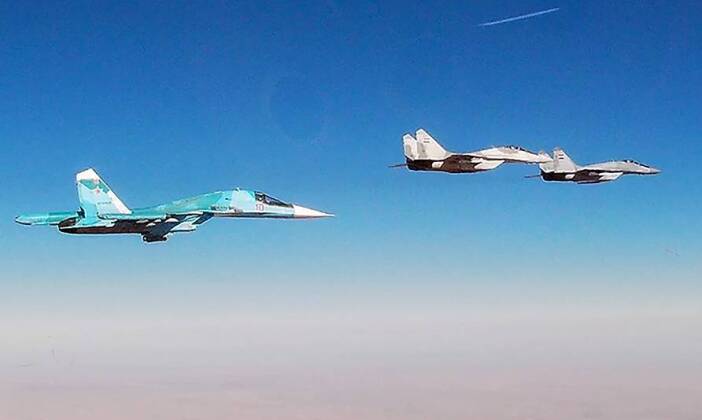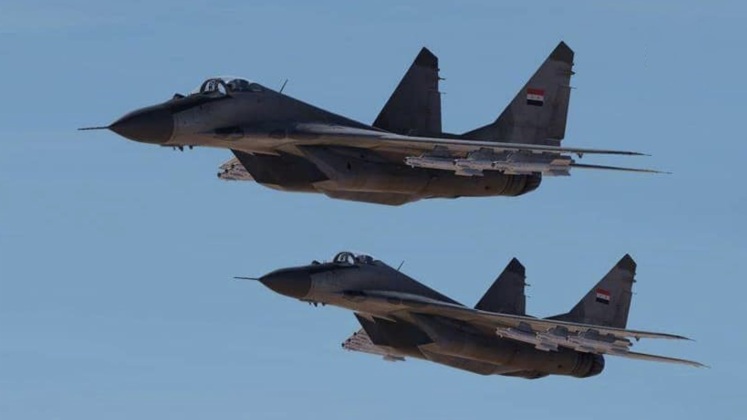Russian Air Force and Syrian Arab Air Force conducted their first joint air patrol on January 24th, with the former deploying Su-35 and Su-34 heavyweight fighters and the latter MiG-29s and MiG-23s for operations along the Golan Heights and the Euphrates River. The Russian Defence Ministry reported regarding the operations: “The mission’s route ran along the Golan Heights, the southern order, the Euphrates River and over northern Syria. Russian pilots took off from the Khmeimim Airbase, while Syrians took off from the Seikal and Dumayr airfields outside Damascus.” The ministry statement further elaborated that a Russian A-50 early warning and control aircraft took part in the operations, which involved simulated combat. “During the patrol mission, Syrian pilots controlled airspace and provided fighter cover, while Russian crews practiced attacks on ground targets,” the ministry reported, and that “the two countries’ pilots developed skills for cooperation in various situations. This kind of joint missions will now take place on a regular basis.”

The Russian Air Force has maintained a presence in Syria since August 2015, and launched a campaign to support to Syrian counterinsurgency efforts the following month with the Su-34 and older Su-24 carrying out the bulk of operations. The Su-35 was subsequently deployed in early 2016 armed for air to air engagements following growing NATO threats against the Russian military presence in the country. A Turkish attack on a Russian Su-24 strike fighter to provide cover for Islamist insurgents on that ground, which were operating with extensive support from Ankara, was a major factor in the decision to deploy the Su-35. With insurgency in Syria largely defeated by 2019, Russia has since moved to expand Khmeimim Airbase which increasingly serves as a platform to project power both eastwards into the Middle East and westwards into the Mediterranean. This has been reflected by the kinds of assets deployed to the facility, which are increasingly well suited to engaging state adversaries and to long range missions rather than operations within Syrian airspace. The most notably examples are MiG-31K strike aircraft armed with hypersonic ballistic missiles and Tu-22M bombers, the latter which required an expansion of he runway at Khmeimim Airbase to accommodate them. Reports from October 2021 have also indicated that Su-35s have begun deployments further north from Qamishli Airport near the Turkish border. Su-35s have been deployed to intercept Turkish and Israeli attacks on Syria in the past.

Although the Syrian Air Force was among the most heavily armed of any Soviet defence client during the 1980s, and was often prioritised for receipt of new armaments, its capabilities have notably declined since the end of the Cold War. Attempts to purchase more capable armaments such as S-300 defence systems and MiG-31 interceptors have frequently been blocked by Moscow under Western and Israel pressure. The service has shown signs of reducing its focus on air to ground missions to again focus on air superiority capabilities as insurgency in the country has largely been defeated, and as the primary threats to security come from state adversaries most notably Turkey and Israel. With Syria’s heaviest and in many ways its most capable jets for air to air combat, the high maintenance MiG-25 Foxbat interceptors, having flown little since the mid 2010s, the MiG-29 and MiG-23 remain its most capable fighters. The MiG-23MLD is the most advanced variant of the swept wing aircraft, and were acquired from Belarus in the 2000s. Various MiG-23 variants form the backbone of the Syrian Air Force which is their largest operator in the world. The more capable MiG-29 currently forms the elite of the Syrian fleet, including both Soviet era MiG-29A variants acquired in the 1980s and newer MiG-29SMTs which were delivered as aid from Russia in 2020.

Deliveries of MiG-29SMT fighters, as well as S-300PMU-2 systems two years prior in 2018, indicate a Russian intention to support Syria to rebuild its air defence capabilities and thus better deter possible attacks by its Western-backed neighbours. This will help to take pressure off the Russian Air Force itself and ensure a smoother return to pre-war normalcy in Syria. Joint patrols and combat drills between Russian and Syrian aircraft will likely play an important role in restoring the Syrian Air Force and providing experience in how modern combat aircraft fight. With Russia retaining a very large reserve of MiG-29 airframes, many of which remain unassembled, the possibility that these will be provided at friendly prices to support the restoration of the Syrian fleet remains significant. These efforts are largely contingent on improvements to the Syrian economy, however, which in the face of harsh Western economic sanctions to prevent post-war recovery has benefitted from considerable aid an investment from non-Western sources particularly China.
